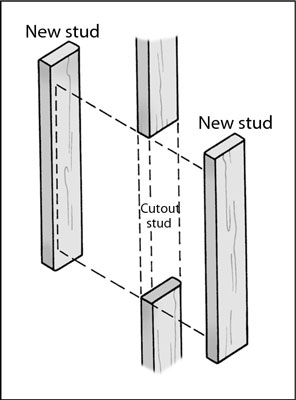To replace a recessed medicine cabinet, choose a replacement cabinet that’s the same or close to the same size as your original cabinet so that it fits in the existing wall cavity. Another good bet is to get a larger cabinet, which you can install after enlarging the opening. It’s relatively easy to measure the additional space needed and enlarge the opening by cutting the wallboard with a drywall saw and modifying the wall framing.
If you have a large hole left from an old recessed cabinet and you choose a smaller cabinet, the job becomes more complicated. You have to apply new wallboard, tape, and compound; let it dry; and then finish the wall with another application, followed by sanding.
If you must cut a stud, install additional short pieces of 2 x 4 at the outside of the cutout to support the cabinet.

To replace a recessed medicine cabinet, you need a drywall saw, a recessed-mount medicine cabinet with fasteners, and shims. Follow these steps for a professional-looking installation:
Empty the old cabinet, take out the shelves and, in some cases, remove the door.
Find the fasteners that hold the cabinet in the wall cavity, remove them and pull out the old cabinet.
If the new cabinet came with the door attached, remove it if possible, following the manufacturer’s instructions.
Store the door carefully to prevent damaging it or any mirror.
Test-fit the cabinet body in the wall cavity.
You should be able to adjust the cabinet to make it level and plumb.
If necessary, remove the cabinet from the cavity and enlarge the opening by cutting the wallboard with a drywall saw.
Reinsert the cabinet into the wall opening and check again to ensure that the cabinet is level and plumb.
Insert the mounting screws in the mounting holes in the cabinet body, following the manufacturer’s instructions, and tighten the screws to secure the cabinet in the opening.
If the cabinet comes with screw covers, snap them in place.
Install the hinge mechanism for the door on the cabinet body and position the door so that it’s properly aligned.
Position the shelf brackets where appropriate and set the shelves on top of the brackets.
Check the door for proper alignment and make any necessary adjustments.

